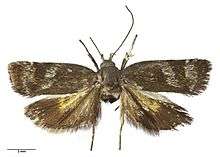Hierodoris bilineata
Hierodoris bilineata is a species of moth in the family Oecophoridae. It is endemic to New Zealand. This species is classified as "At Risk, Naturally Uncommon" by the Department of Conservation. It is possible that this species gives birth to live young rather than lay eggs as is the norm.
| Hierodoris bilineata | |
|---|---|
 | |
| Holotype specimen | |
| Scientific classification | |
| Kingdom: | |
| Phylum: | |
| Class: | |
| Order: | |
| Family: | |
| Genus: | |
| Species: | H. bilineata |
| Binomial name | |
| Hierodoris bilineata (Salmon, 1948)[1] | |
| Synonyms[2] | |
| |
Taxonomy
This species was first described by John Tenison Salmon in 1948 using specimens obtained from flowering kanuka trees on Great Island, Three Kings Islands by E. G. Turbot and named Heliostibes bilineata.[2][3] In 1988 John S. Dugdale assigned the species to the genus Hierodoris.[2] The holotype specimen is held at the Auckland War Memorial Museum.[2]
Description
Salmon describes the species as follows:
The expansion of the wings is 15mm. The forewings are somewhat rectangular in shape, on the distal half, with the costa strongly arched to the base ; dark brown in colour with a cloudy blackish spot at the centre and another at two-thirds ; between these two spots from the costa almost to the dorsum runs a broad band of whitish scales superimposed upon the ground of dark-brown; beyond the distal blackish spot is a second similar whitish line ; these two lines are inclined toward one another and may be joined by a thin line above the dorsum giving the appearance of a broad "U"-shaped band. There is a small tuft of whitish scales basally scattered over the entire forewings and impart a pleasing bronzy reflection to them. Hind wings are dark-brown with the costa broadly white basally, narrowing towards the apex, and shaded with bright orange-yellow from the base almost to the centre. Cilia of the fore-wings dark brown, of the hind wings ochreous-brown shaded with dark-brown at the base. Head and thorax heavily scaled; patagia small, dark brown. Body entirely dark-brown above with transverse intersegmental bands of bright-orange across the abdomen ; below it is profusely shaded with whitish scales. Legs, antennae, and palpi dark-brown similarly shaded with whitish scales.[3]
H. bilineata can be distinguished from other species in its genus as it has unmarked and unmodified antennae, a non-metallic appearance to its thorax and it is smaller in size than other species of similar appearance.[4]
Distribution
This species is endemic to New Zealand.[1][5] It is likely that H. bilineata is found only at the Three Kings Islands.[4] Along with its type locality of Great Island, it has also been collected from South West Island.[4]
Biology and behaviour
Little is known of the biology of this species.[4] It has been hypothesised, as a result of the discovery of a larva in the oviduct of a female moth during dissection, that this species gives birth to live young rather than laying eggs.[4] The adults of this species are on the wing in April and May.[3]
Host species and habitat
The host species for the larvae of this moth is currently unknown however it appears that this species is associated with Kunzea ericoides.[4]
Conservation Status
This species has been classified as having the "At Risk, Naturally Uncommon" conservation status under the New Zealand Threat Classification System.[6]
References
| Wikimedia Commons has media related to Hierodoris bilineata. |
- "Hierodoris bilineata (Salmon, 1948)". www.nzor.org.nz. Landcare Research New Zealand Ltd. Retrieved 22 May 2018.
- Dugdale, J. S. (1988). "Lepidoptera - annotated catalogue, and keys to family-group taxa" (PDF). Fauna of New Zealand. 14: 89. Retrieved 22 May 2018.
- Salmon, J. T. (1948). "New species and records of Lepidoptera from the Three Kings Islands, New Zealand". Records of the Auckland Institute and Museum. 3: 309–311.
- Hoare, R. J. B. (2005). "Hierodoris (Insecta: Lepidoptera: Gelechioidea: Oecophoridae), and overview of Oecophoridae" (PDF). Fauna of New Zealand. 54: 1–102. ISBN 0478093780.
- Gordon, Dennis P., ed. (2010). New Zealand inventory of biodiversity. Volume two. Kingdom animalia : chaetognatha, ecdysozoa, ichnofossils. Vol. 2. Christchurch, N.Z.: Canterbury University Press. p. 462. ISBN 9781877257933. OCLC 973607714.
- Hoare, R.J.B.; Dugdale, J.S.; Edwards, E.D.; Gibbs, G.W.; Patrick, B.H.; Hitchmough, R.A.; Rolfe, J.R. (2017). "Conservation status of New Zealand butterflies and moths (Lepidoptera), 2015" (PDF). New Zealand Threat Classification Series. 20: 8.